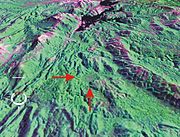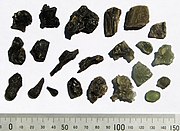world.wikisort.org - Australia
Darwin Crater is a suspected meteorite impact crater in Western Tasmania about 26 km (16 mi) south of Queenstown, just within the Franklin-Gordon Wild Rivers National Park. The crater is expressed as a rimless circular flat-floored depression, 1.2 km (0.75 mi) in diameter, within mountainous and heavily forested terrain. It is east of the West Coast Range and the former North Mount Lyell Railway formation.
| Darwin Crater Tasmania | |
|---|---|
 False-colour Landsat image of Darwin Crater (arrowed); screen capture from NASA World Wind | |
 Darwin Crater | |
| Coordinates | 42°18′15″S 145°39′27″E |
Discovery and description
The crater was discovered by the geologist R. J. Ford in 1972, after a search for the source of Darwin glass,[1] an impact glass found over more than 400 square kilometres (150 sq mi) of southwestern Tasmania.[2] Geophysical investigations and drilling have shown that the crater is filled with up to 230 metres (750 ft) of breccia capped by Pleistocene lake sediments.[3][4] Although definitive proof of an impact origin of the crater is lacking, the impact hypothesis is strongly supported by the relationship of the glass to the crater, as well as the stratigraphy and deformation of the crater-filling material.[4]
If the crater is indeed the source of the glass, the age of Darwin Crater is 816,000 ± 7,000 years—the age of Darwin glass as determined by argon–argon dating method.[5]
Carbonaceous inclusions have been found for the first time in Darwin glass: these have been shown to be biomarkers which survived the Darwin impact and are representative of plant species in the local ecosystem—including cellulose, lignin, aliphatic biopolymer and protein remnants.[6]
Access
While there is a trail leading to the crater, personal recounts note that it is unmaintained, overgrown and boggy in places.[7][8]
Gallery
See also
- List of impact craters in Australia
- Protected areas of Tasmania
References
- Ford, R.J. (1972). "A possible impact crater associated with Darwin glass". Earth and Planetary Science Letters. 16 (2): 228–230. Bibcode:1972E&PSL..16..228F. doi:10.1016/0012-821X(72)90194-X.
- Howard, K.T.; Haines, P.W. (2003). "Distribution And Abundance Of Darwin Impact Glass" (PDF). Third International Conference on Large Meteorite Impacts.
- Fudali, R.F.; Ford, R.J. (1979). "Darwin glass and Darwin crater - A progress report". Meteoritics. 14: 283–296. Bibcode:1979Metic..14..283F.
- Howard, K.T.; Haines, P.W. (2007). "The geology of Darwin Crater, western Tasmania, Australia". Earth and Planetary Science Letters. 260 (1–2): 328–339. Bibcode:2007E&PSL.260..328H. doi:10.1016/j.epsl.2007.06.007.
- Lo, C.H.; Howard, K.T.; Chung, S.L.; Meffre, S. (2002). "Laser-fusion 40Ar/39Ar Ages of Darwin Impact Glass". Meteoritics & Planetary Science. 37 (11): 1555–1562. Bibcode:2002M&PS...37.1555L. doi:10.1111/j.1945-5100.2002.tb00810.x.
- Howard, K.T.; Bailey, M.J.; et al. (2013). "Biomass preservation in impact melt ejecta". Nature Geoscience. 6: 1018–1022. Bibcode:2013NatGe...6.1018H. doi:10.1038/NGEO1996.
- Brattstorm (15 April 2009). "Darwin Crater". Retrieved 14 June 2017.
- Novak, Martin (26 November 2012). "Darwin Crater Trip Report". backpackertas.com.au. Retrieved 15 June 2017.
External links
Further reading
Howard, Kieren Torres (2004). Origin of Darwin glass. University of Tasmania.
Другой контент может иметь иную лицензию. Перед использованием материалов сайта WikiSort.org внимательно изучите правила лицензирования конкретных элементов наполнения сайта.
WikiSort.org - проект по пересортировке и дополнению контента Википедии



